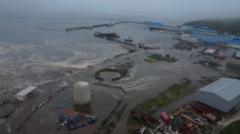A powerful earthquake registering 8.8 on the Richter scale struck near the Kamchatka Peninsula in Russia, at 11:25am local time (00:25am BST) on Wednesday. This intense seismic event is thought to be one of the strongest earthquakes ever recorded and has set off tsunami warnings across the Pacific Ocean.
The ramifications of the earthquake prompted millions to evacuate from regions in Japan, Russia, and parts of the US West Coast. Additionally, alerts have been issued for countries as far away as China, the Philippines, Indonesia, New Zealand, Peru, and Mexico.
Evidence of the devastation emerged quickly, with footage showing significant wave activity inundating the coastal town of Severo-Kurilsk, Russia. Local officials reported that both a port and fish processing plant were affected by flooding, and harbor vessels were dislocated. The Sakhalin region suffered power grid failures as a result of the disaster.
In Japan, an estimated 1.9 million residents were ordered to evacuate; authorities advised people to seek higher ground, urging individuals to take refuge atop buildings in cities like Hokkaido. Meanwhile, officials in Hawaii issued warnings concerning potential waves reaching up to 10 feet, although Hawaii's governor, Josh Green, noted that “a wave of consequence” had not yet materialized, adding that it would take an additional two to three hours for authorities to provide an all-clear notification.
Experts remain uncertain about the extent of the damage, as tsunami waves continue to unfold across the Pacific. Chris Goldfinger, a Professor of Marine Geology at Oregon State University, explained, “Each country, each port, and each coastline will experience a very site-specific response.” Some areas are anticipating mild effects, while others could face significant damage. He indicated that the outcome largely relies upon the path of energy dispersing from the epicenter in Kamchatka.
The timeline of the tsunami's reach is critical, with estimates suggesting waves may strike parts of British Columbia and California by 12:20am local time (09:20am BST) and however, Nome, Alaska could see waves by 03:20am (12:20pm BST). As research indicates, such tsunami waves travel at approximate speeds of a jet aircraft, determining their arrival time based on distance.
This earthquake is classified as one of the most severe globally, ranking sixth historically, now tied with notable quakes in Chile and Ecuador. The earthquake was recorded at a depth of 19.3 km (12 miles) and had prompted a series of aftershocks. Comparatively, it does not exceed the 2004 Indian Ocean earthquake and tsunami, which resulted in over 227,000 fatalities.


















